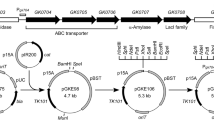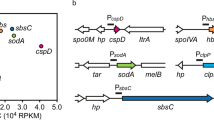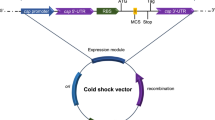Abstract
The effects of mitomycin C on C1857-controlled recombinant gene expression have been explored in E. coli cultures when the drug was added simultaneously to the thermal induction. A significantly improved yield of homologous, heterologous and chimeric fusion proteins was observed in E. coli MC1061 and GE864 (a MC4100 derivative) thermoinduced cells. This feature was not detected in other E. coli strains and does not involve a gene dosage mechanism but a strain-dependent stimulation of gene expression unrelated to the RecA protease activity.
Similar content being viewed by others
References
Bachmann BJ (1972) Pedigrees of some mutant strains of Escherichia coli K-12. Bacteriol Rev 36:525–557
Benito A, Vidal M, Villaverde A (1993) Enhanced production of p l-controlled recombinant proteins and plasmid stability in Escherichia coli RecA + strains. J Biotechnol 29:299–306
Bertrand-Burggraf E, Oertel P, Schnarr M, Daune M, Granger-Schnarr M (1989) Effect of induction of SOS response on expression of pBR322 genes and on plasmid copy number. Plasmid 22:163–168
Casadaban MJ, Cohen SN (1980) Analysis of gene control signals by DNA fusion and cloning in Escherichia coli. J Mol Biol 138:179–207
Casadaban MJ, Chou J, Cohen SN (1980) In vitro gene fusions that join an active β-galactosidase segment to amino terminal fragments of exogenous proteins: Escherichia coli plasmid vectors for detection and cloning of translational initiation signals. J Bacteriol 143:971–980
Caulcott CA, Rhodes M (1986) Temperature-induced synthesis of recombinant proteins. Trends Biotechnol 2:142–146
Howard-Flanders P, Boyce RP (1966) DNA repair and genetic recombination: studies on mutants of E. coli defective in these processes. Radiation Res [Suppl] 6:156–184
Kenyon CJ, Walker GC (1980) DNA-damaging agents stimulate gene expression at specific loci in E. coli. Proc Natl Acad Sci USA 77:2819–2823
Larminat F, Defais M (1989) Modulation of the SOS response by truncated RecA proteins. Mol Gen Genet 216:106–112
Lieb M (1979) Heat-sensitive lambda repressors retain partial activity during bacteriophage induction. J Virol 32:162–166
Little J (1984) Autodigestion of lexA and phage λ repressors Proc Natl Acad Sci USA 81:1375–1379
Little J, Edmiston S, Pacelli L, Mount D (1980) Cleavage of the Escherichia coli lexA protein by the recA protease. Proc Natl Acad Sci USA 77:3225–3229
Mateu MG, Martínez MA, Capucci L, Andreu D, Giralt E, Brocchi E, Domingo E (1990) A single amino acid substitution affects multiple overlapping epitopes in the major antigenic site of foot-and-mouth disease virus of serotype C. J Gen Virol 71:629–637
Miller JH (1972) Experiments in molecular genetics. Cold Spring Harbor Laboratory, Cold Spring Harbor, NY
Mott JE, Grant RA, Ho Y, Platt T (1985) Maximizing gene expression from plasmid vectors containing the lambda p l promoter: strategies for overproducing transcription termination factor p. Proc Natl Acad Sci USA 82:88–92
Petranovic M, Salaj-Smic E, Petranovic D, Trogovcevic Z (1979) Inactivation of prophage in ultraviolet-irradied Escherichia coli: dependence on recA gene activity. J Bacteriol 140:848–851
Poindexter K, Gayle RB (1991) Induction of recombinant gene expression in Escherichia coli using an alkaline pH shift. Gene 97:125–130
Roberts JW, Roberts CW, Craig NL (1978) Escherichia coli recA gene product inactivates phage λ repressor. Proc Natl Acad Sci USA 75:4714–4718
Salles B, Weinstock GM (1989) Interaction of the CRP-cAMP complex with the cea regulatory region. Mol Gen Genet 215:537–542
Sambrook J, Fritsch EF, Maniatis T (1989) Molecular cloning: a laboratory manual. Cold Spring Harbor Laboratory, Cold Spring Harbor, NY
Schauder B, Blöcker H, Frank R, McCarthy J E G (1987) Inducible vectors incorporating the Escherichia coli atp E translational initiation region. Gene 52:279–283
Vidal M, Cairó J, Mateu MG, Villaverde A (1991) Molecular cloning and expression of the VP1 gene of foot-and-mouth disease virus C1 in E. coli: effect on bacterial cell viability. Appl Microbiol Biotechnol 35:788–792
Villaverde A, Benito A, Viaplana E, Cubarsi R (1993) Fine regulation of cI857-controlled gene expression in continuous culture of recombinant Escherichia coli by temperature. Appl Environ Microbiol 59:3485–3487
Zaballos A, Salas M, Mellado RP (1987) A set of plasmids for the synthesis of fused and unfused polypeptides in Escherichia coli. Gene 58:67–76
Author information
Authors and Affiliations
Rights and permissions
About this article
Cite this article
Corchero, J.L., Carbonell, X., Benito, A. et al. Mitomycin C stimulates thermally induced recombinant gene expression in Escherichia coli MC strains. Appl Microbiol Biotechnol 42, 890–894 (1995). https://doi.org/10.1007/BF00191187
Received:
Revised:
Accepted:
Issue Date:
DOI: https://doi.org/10.1007/BF00191187




